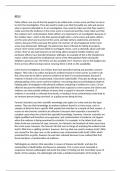Essay
WJEC Level 3 Criminology UNIT 3 Crime scene To Courtroom Example answers
- Course
- Institution
These are example answers you can use for inspiration for the answers you want to write in the WJEC Level 3 Criminology UNIT 3 Controlled Assessment. With these answers I was able to secure an A in the exam. The reason the quantity is so low, and I still achieved an A is because I made sure to incl...
[Show more]



